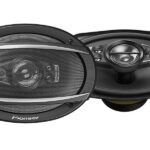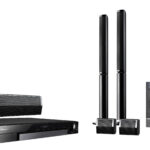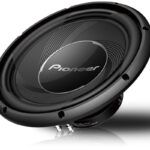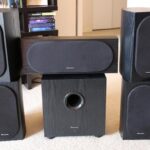To use a second receiver as an amp, connect the audio output of the main receiver to the audio input of the second receiver using RCA cables. Then, select the appropriate input on the second receiver and adjust the volume accordingly.
This allows you to utilize the second receiver’s amplification capabilities to enhance the sound output of your audio system. This can be especially useful if you have a passive subwoofer that requires additional amplification. With this setup, you can effectively increase the power and quality of your audio playback without the need for an external amplifier.
So, whether you’re a music enthusiast or a movie buff, using a second receiver as an amp can greatly enhance your audio experience.
Enhancing Your Audio Experience With A Second Receiver
Enhancing your audio experience with a second receiver can greatly improve the sound quality of your setup. Understanding receiver compatibility is crucial in ensuring that your equipment works together seamlessly.
When using a second receiver as an amp, it’s important to note that not all receivers are designed to work in this manner. Before making a purchase, check the specifications to ensure that the receiver supports being used as an amplifier.
Once you have a compatible receiver, connecting it to your existing setup is relatively simple. Begin by connecting the audio output from your primary receiver to the audio input of the second receiver. This can typically be done using standard RCA or HDMI cables.
Next, configure the second receiver to function as an amplifier. This may involve adjusting the settings on both receivers to ensure proper signal flow and optimization. Consult the manuals for both receivers for specific instructions.
By utilizing a second receiver as an amp, you can enhance the sound quality of your audio setup and create a more immersive listening experience. Remember to ensure compatibility and properly configure your equipment for optimal performance.
Step-By-Step Guide To Connecting Your Second Receiver
Step-by-Step Guide to Connecting Your Second Receiver
To utilize your second receiver as an amp, it’s crucial to follow a systematic approach to ensure a seamless connection between the two devices. Here is a simplified guide to help you through the process:
1. Identifying necessary cables and connections:
Determine the type of cables and connectors needed to establish the connection between your primary receiver and the second receiver. Commonly used cables include HDMI, RCA, or optical cables. Ensure you have the required cables and adapters on hand before proceeding.
2. Establishing a secure connection between the two receivers:
Once you have the necessary cables, connect the audio outputs of your primary receiver to the audio inputs of the second receiver. Make sure the connections are secure to avoid any audio disruptions. Refer to the user manuals of both receivers for precise instructions on how to make the connections.
3. Adjusting audio settings for optimum performance:
After establishing the physical connection, you may need to adjust the audio settings on both receivers. Configure the second receiver to act as an amplifier by switching off unnecessary features like equalizers or tone controls. Ensure the audio signal is passing through without any distortion or interference.
By meticulously following these steps, you can successfully utilize your second receiver as an amplifier, enhancing your audio experience without the need for an additional external amp.
Optimizing Sound Output and Control
In order to fully utilize a second receiver as an amp, it is crucial to understand the various sound modes that are available. These sound modes, such as stereo, surround sound, and Dolby Atmos, provide different audio experiences based on personal preferences.
To enhance your audio experience, it is important to make use of the equalization settings provided by the receiver. Adjusting the bass, treble, and other audio settings according to your preferences can greatly improve the sound output. Customizing these settings allows you to create a personalized audio profile that suits your individual taste.
In order to achieve optimal audio performance, it is crucial to maximize the power output of the second receiver. This can be done by configuring the receiver’s settings to ensure maximum power is being delivered to the speakers. By doing so, you can enjoy enhanced audio quality and a more immersive sound experience.
Potential Challenges And Troubleshooting Tips
Using a second receiver as an amp can bring about a range of challenges. Sound quality problems are some of the common issues encountered. There are troubleshooting techniques that can be employed to address these problems effectively.
| Common Issues | Troubleshooting Techniques |
|---|---|
| 1. Distorted sound | Check the audio connections and ensure they are secure. Adjust the volume levels and verify that the audio inputs and outputs are compatible. |
| 2. Low volume output | Confirm that the receiver is properly powered. Check the wiring and connections for any issues. Adjust the settings on both receivers to optimize the audio output. |
| 3. No sound | Check the input and output sources to ensure they are properly connected. Verify that all the necessary cables are securely plugged in. Investigate the audio settings and adjust them accordingly. |
| 4. Audio delay | Review the audio synchronization settings on both receivers. Update the firmware if applicable. Consider using a dedicated audio delay device if necessary. |
By addressing these common challenges, you can enhance your experience when using a second receiver as an amp. Troubleshooting the sound quality problems will ensure optimal audio performance.
Alternative Options For Amplifying Sound
Alternative Options for Amplifying Sound
When it comes to amplifying sound, there are various alternative methods available apart from using a traditional amplifier. Exploring these options can help you find the best solution for your needs. Here are some alternatives to consider:
- Using a Second Receiver as an Amp: One option is to utilize a second receiver as an amp. This involves connecting your audio source to a receiver’s auxiliary input and then connecting the receiver’s outputs to your speakers. While this method may work in certain situations, it’s important to assess the compatibility and power output.
- Using Powered Speakers: Another alternative is to use powered speakers, which come with built-in amplifiers. These speakers can be directly connected to your audio source without the need for a separate amplifier. This option offers convenience and simplicity.
- Utilizing a Digital Audio Converter (DAC): A DAC can be employed to convert digital audio signals into analog signals, which can then be amplified by a separate amp. This method works well for improving sound quality and connecting devices with different output types.
- Exploring Integrated Amplifiers: Integrated amplifiers are all-in-one devices that combine both a preamplifier and power amplifier. They provide a compact and efficient solution for amplifying sound.
Assessing the advantages and disadvantages of these different options can assist you in making an informed decision based on your specific requirements. Keep in mind factors such as compatibility, power output, convenience, and sound quality.
Frequently Asked Questions On How To Use A Second Receiver As An Amp
Can I Use A Second Receiver As An Amplifier?
Yes, you can use a second receiver as an amplifier. Simply connect the audio output of your main receiver to the audio input of the second receiver. Adjust the volume and settings accordingly, and you’ll be able to enjoy amplified audio from your second receiver.
What Is The Benefit Of Using A Second Receiver As An Amp?
Using a second receiver as an amplifier allows you to enhance the audio quality and power of your sound system. It can help you achieve a fuller, richer sound experience, especially when paired with high-quality speakers. Additionally, it provides flexibility in expanding your audio setup without investing in a separate amplifier.
How Do I Connect A Second Receiver To Use It As An Amp?
To connect a second receiver as an amplifier, use RCA audio cables to connect the audio output of your main receiver (usually labeled “Pre-Out”) to the audio input of the second receiver (usually labeled “Aux-In” or “CD-In”). Make sure to select the appropriate input on the second receiver and adjust the volume levels accordingly.
Can I Connect Multiple Devices To The Second Receiver Used As An Amp?
Yes, you can connect multiple devices to the second receiver used as an amplifier. Simply utilize the available inputs on the second receiver, such as auxiliary or HDMI inputs, to connect various audio sources. This allows you to switch between devices and enjoy amplified sound from each of them.
Conclusion
To summarize, using a second receiver as an amp can be a cost-effective solution for enhancing your audio setup. By following the step-by-step guide provided, you can effectively utilize your existing equipment to amplify sound and improve your listening experience.
Whether you’re a music lover or a home theater enthusiast, this method offers an affordable option to achieve high-quality audio output. Start exploring the potential of your second receiver today and elevate your audio performance without breaking the bank.








